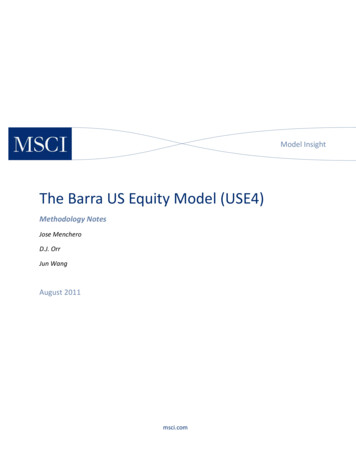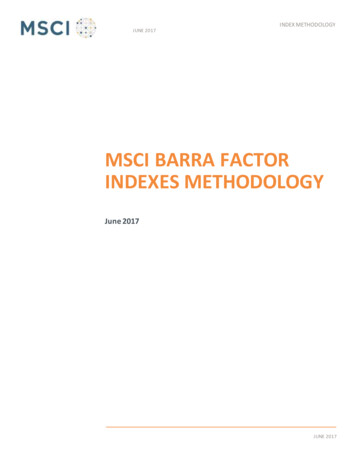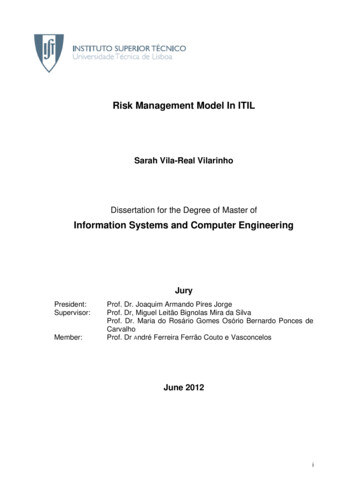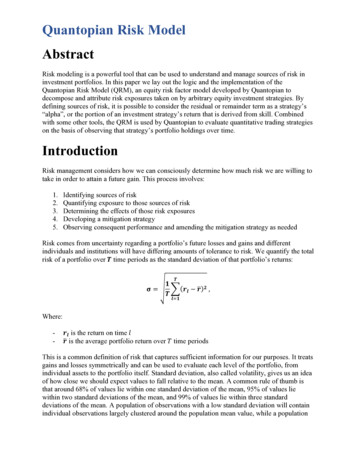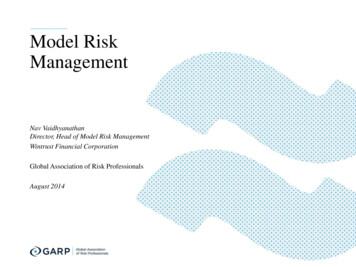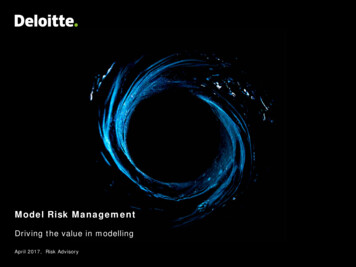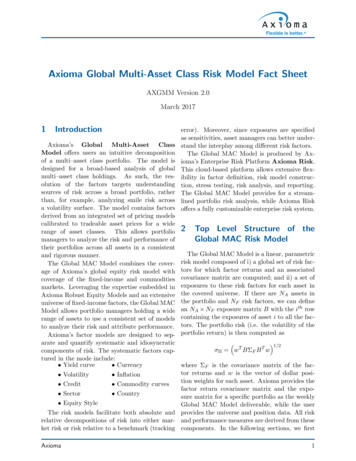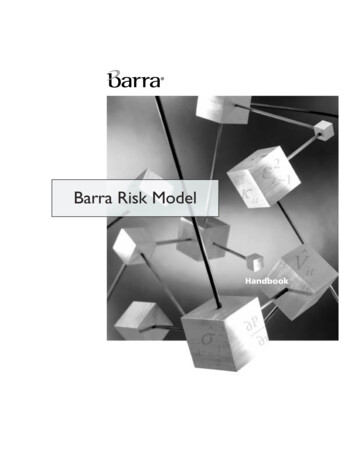
Transcription
Barra Risk ModelHandbook
Copyright 2004 Barra, Inc and/or its subsidiaries and affiliates (“Barra”). All rights reserved. This publication shall be used only in accordance with the terms ofyour license agreement with Barra, but in any event, only for your internal business use. This publication is the confidential and proprietary property of Barra. Nopart of this publication may be reproduced, transmitted, or distributed in any form by any means (electronic, photocopying or otherwise) without the prior writtenconsent of Barra. Barra is a registered trademark, and other Barra product names, service names, slogans or logos referenced in this publication are trademarks,servicemarks, registered trademarks or registered servicemarks of Barra, Inc. and/or its subsidiaries and affiliates. All other company, product or service names referenced in this publication are used for identification purposes only and may be trademarks of their respective owners.BARRA AND ITS SUPPLIERS DISCLAIM ALL WARRANTIES, EXPRESS OR IMPLIED, REGARDING THIS PUBLICATION AND THE PRODUCTS AND SERVICES REFERENCEDHEREIN (AND ANY RESULTS TO BE OBTAINED FROM THE USE THEREOF), INCLUDING BUT NOT LIMITED TO ALL WARRANTIES OF MERCHANTABILITY, FITNESSFOR A PARTICULAR PURPOSE OR USE, ORIGINALITY, AND ALL WARRANTIES ARISING FROM COURSE OF PERFORMANCE, COURSE OF DEALING AND USAGE OFTRADE OR THEIR EQUIVALENTS UNDER THE LAWS OF ANY JURISDICTION. THIS PUBLICATION AND THE PRODUCTS AND SERVICES PROVIDED TO YOU AREPROVIDED “AS IS.” Accuracy, consistency and completeness of data in this publication and the products and services are not guaranteed. Neither Barra nor any ofits suppliers warrant that the products or services referenced in this publication will be uninterrupted or free from error or from unauthorized hidden programsintroduced into such products without their knowledge. Barra products contain a number of analytical tools that should be used only by sophisticated investmentprofessionals. There is no assurance that the financial instruments identified by the products will perform in a manner that is consistent with their historical characteristics or assure the profitability or utility of forecasts or expected values. Barra shall not be deemed to be providing investment management, supervision or advisory services.RV 03-2004
ContentsAbout Barra . . . . . . . . . . . . . . . . . . . . . . . . . . . . . . . . . . . . . . . . . vA Pioneer in Risk Management . . . . . . . . . . . . . . . . . . . . . . . . . . . vContacting Barra . . . . . . . . . . . . . . . . . . . . . . . . . . . . . . . . . . . . .viOther Barra Resources . . . . . . . . . . . . . . . . . . . . . . . . . . . . . . . . .viIntroduction . . . . . . . . . . . . . . . . . . . . . . . . . . . . . . . . . . . . . . . . vii1. Forecasting Risk with Multiple-Factor Models . . . . . . . . . . . .1What Are Multiple-Factor Models? . . . . . . . . . . . . . . . . . . . . . . . . 1How Do Multiple-Factor Models Work? . . . . . . . . . . . . . . . . . . . . 2Advantages of Multiple-Factor Models. . . . . . . . . . . . . . . . . . . . . . 2An Illustration of Multiple-Factor Models . . . . . . . . . . . . . . . . . . . 3Model Mathematics . . . . . . . . . . . . . . . . . . . . . . . . . . . . . . . . . . . 5Single-Factor Model . . . . . . . . . . . . . . . . . . . . . . . . . . . . . . . . 6Multiple-Factor Model . . . . . . . . . . . . . . . . . . . . . . . . . . . . . . 6Multiple-Asset Portfolio . . . . . . . . . . . . . . . . . . . . . . . . . . . . . 8Risk Prediction with MFMs . . . . . . . . . . . . . . . . . . . . . . . . . . . . . 8The Covariance Matrix . . . . . . . . . . . . . . . . . . . . . . . . . . . . . 10Deriving the Variance-Covariance Matrix of Asset Returns. . . 10Final Risk Calculation . . . . . . . . . . . . . . . . . . . . . . . . . . . . . 11Summary . . . . . . . . . . . . . . . . . . . . . . . . . . . . . . . . . . . . . . . . . . 122. Forecasting Equity Risk . . . . . . . . . . . . . . . . . . . . . . . . . . . .15A Historical Perspective . . . . . . . . . . . . . . . . . . . . . . . . . . . . . . . 15Barra’s Equity Multiple-Factor Model . . . . . . . . . . . . . . . . . . . . . 19Common Factors . . . . . . . . . . . . . . . . . . . . . . . . . . . . . . . . . . . . 20Risk Indices . . . . . . . . . . . . . . . . . . . . . . . . . . . . . . . . . . . . . 20Industries . . . . . . . . . . . . . . . . . . . . . . . . . . . . . . . . . . . . . . . 20Specific Risk . . . . . . . . . . . . . . . . . . . . . . . . . . . . . . . . . . . . . . . . 20Contentsi
3. Barra Equity Risk Modeling . . . . . . . . . . . . . . . . . . . . . . . . 21Model Estimation Overview . . . . . . . . . . . . . . . . . . . . . . . . . . . . 21Data Acquisition . . . . . . . . . . . . . . . . . . . . . . . . . . . . . . . . . . . . 24Descriptor Selection and Testing . . . . . . . . . . . . . . . . . . . . . . . . . 24Descriptor Standardization . . . . . . . . . . . . . . . . . . . . . . . . . . . . . 25Risk Index Formulation . . . . . . . . . . . . . . . . . . . . . . . . . . . . . . . 25Industry Allocation. . . . . . . . . . . . . . . . . . . . . . . . . . . . . . . . . . . 26Factor Return Estimation . . . . . . . . . . . . . . . . . . . . . . . . . . . . . . 27Covariance Matrix Calculation . . . . . . . . . . . . . . . . . . . . . . . . . . 27Exponential Weighting . . . . . . . . . . . . . . . . . . . . . . . . . . . . . 28Covariance Matrix Scaling: Computing Market Volatility . . . 29Specific Risk Modeling . . . . . . . . . . . . . . . . . . . . . . . . . . . . . . . . 33Methodology . . . . . . . . . . . . . . . . . . . . . . . . . . . . . . . . . . . . 33Updating the Model . . . . . . . . . . . . . . . . . . . . . . . . . . . . . . . . . . 354. Forecasting Fixed-Income Risk . . . . . . . . . . . . . . . . . . . . . . 39A Historical Perspective . . . . . . . . . . . . . . . . . . . . . . . . . . . . . . . 39Barra’s Multiple-Factor Model . . . . . . . . . . . . . . . . . . . . . . . . . . . 40Common Factors . . . . . . . . . . . . . . . . . . . . . . . . . . . . . . . . . . . . 41Interest Rate Risk . . . . . . . . . . . . . . . . . . . . . . . . . . . . . . . . . 43Spread Risk . . . . . . . . . . . . . . . . . . . . . . . . . . . . . . . . . . . . . 46Specific Risk . . . . . . . . . . . . . . . . . . . . . . . . . . . . . . . . . . . . . . . 49Summary . . . . . . . . . . . . . . . . . . . . . . . . . . . . . . . . . . . . . . . . . . 495. Interest Rate Risk Modeling . . . . . . . . . . . . . . . . . . . . . . . . 51Estimation Process Overview . . . . . . . . . . . . . . . . . . . . . . . . . . . 51Term Structure Specification . . . . . . . . . . . . . . . . . . . . . . . . . . . . 55Interpolation . . . . . . . . . . . . . . . . . . . . . . . . . . . . . . . . . . . . 55Estimation Algorithm Implementation . . . . . . . . . . . . . . . . . 58Factor Shape Determination . . . . . . . . . . . . . . . . . . . . . . . . . . . . 63Factor Exposure Calculation . . . . . . . . . . . . . . . . . . . . . . . . . . . . 64Factor Return Estimation . . . . . . . . . . . . . . . . . . . . . . . . . . . . . . 65Term Structure Covariance Matrix Construction . . . . . . . . . . . . . 66Covariance Matrix Rotation . . . . . . . . . . . . . . . . . . . . . . . . . . . . 66Updating the Model . . . . . . . . . . . . . . . . . . . . . . . . . . . . . . . . . . 68iiBarra Risk ModelHandbook
6. Spread Risk Modeling . . . . . . . . . . . . . . . . . . . . . . . . . . . . .71Swap Spread Risk Model . . . . . . . . . . . . . . . . . . . . . . . . . . . . . . . 72Data Acquisition and Factor Return Estimation. . . . . . . . . . . 72Factor Exposure Calculation . . . . . . . . . . . . . . . . . . . . . . . . . 72Detailed Credit Spread Risk Model . . . . . . . . . . . . . . . . . . . . . . . 74Currency Dependence . . . . . . . . . . . . . . . . . . . . . . . . . . . . . 74Model Structure . . . . . . . . . . . . . . . . . . . . . . . . . . . . . . . . . . 76Data Acquisition . . . . . . . . . . . . . . . . . . . . . . . . . . . . . . . . . 79Factor Return Estimation . . . . . . . . . . . . . . . . . . . . . . . . . . . 79Covariance Matrix Estimation. . . . . . . . . . . . . . . . . . . . . . . . 79Factor Exposure Calculation . . . . . . . . . . . . . . . . . . . . . . . . . 80Emerging-Market Risk Modeling . . . . . . . . . . . . . . . . . . . . . . . . 80Model Structure . . . . . . . . . . . . . . . . . . . . . . . . . . . . . . . . . . 81Data Acquisition and Factor Return Estimation. . . . . . . . . . . 82Covariance Matrix Estimation. . . . . . . . . . . . . . . . . . . . . . . . 82Factor Exposure Calculation . . . . . . . . . . . . . . . . . . . . . . . . . 83Updating the Model . . . . . . . . . . . . . . . . . . . . . . . . . . . . . . . . . . 837. Specific Risk Modeling. . . . . . . . . . . . . . . . . . . . . . . . . . . . .85Heuristic Models . . . . . . . . . . . . . . . . . . . . . . . . . . . . . . . . . . . . 85Data Acquisition . . . . . . . . . . . . . . . . . . . . . . . . . . . . . . . . . 85Sovereign, U.S. Agency, and MBS Specific Risk Estimation . . 86Corporate Bond Specific Risk Estimation . . . . . . . . . . . . . . . 87Transition-Matrix-Based Model. . . . . . . . . . . . . . . . . . . . . . . . . . 88Data Acquisition . . . . . . . . . . . . . . . . . . . . . . . . . . . . . . . . . 89Transition Matrix Generation . . . . . . . . . . . . . . . . . . . . . . . . 89Rating Spread Level Calculation . . . . . . . . . . . . . . . . . . . . . . 90Credit Migration Forecasting . . . . . . . . . . . . . . . . . . . . . . . . 93Updating the Model . . . . . . . . . . . . . . . . . . . . . . . . . . . . . . . . . . 968. Currency Risk Modeling . . . . . . . . . . . . . . . . . . . . . . . . . . . .99Model Structure . . . . . . . . . . . . . . . . . . . . . . . . . . . . . . . . . . . . . 99Data Acquisition and Return Calculation . . . . . . . . . . . . . . . . . 100Estimation of the Covariance Matrix . . . . . . . . . . . . . . . . . . . . . 100Currency Correlation Model . . . . . . . . . . . . . . . . . . . . . . . . 101Currency Volatility Model. . . . . . . . . . . . . . . . . . . . . . . . . . 102Contentsiii
Volatility Across Markets . . . . . . . . . . . . . . . . . . . . . . . . . . 104Time-Scaling Currency Risk Forecasts . . . . . . . . . . . . . . . . . . . . 107Updating the Model . . . . . . . . . . . . . . . . . . . . . . . . . . . . . . . . . 1089. Integrated Risk Modeling . . . . . . . . . . . . . . . . . . . . . . . . . 111Model Integration Overview . . . . . . . . . . . . . . . . . . . . . . . . . . 111Building Global Asset Class Models . . . . . . . . . . . . . . . . . . . . . 112The Structure of Local Models . . . . . . . . . . . . . . . . . . . . . . 113Aggregating Local Models . . . . . . . . . . . . . . . . . . . . . . . . . . 113Implementing Global Factor Models . . . . . . . . . . . . . . . . . . 115Consistency Between Local Models and Global Model . . . . 116Global Equities. . . . . . . . . . . . . . . . . . . . . . . . . . . . . . . . . . . . . 116Global Equity Factors . . . . . . . . . . . . . . . . . . . . . . . . . . . . . 117Exposures of Local Equity Factors to Global Equity Factors . 117Estimating Returns to Global Equity Factors . . . . . . . . . . . . 117Computing Covariances of Global Equity Factors . . . . . . . . 119Scaling to Local Markets. . . . . . . . . . . . . . . . . . . . . . . . . . . 119Global Bonds . . . . . . . . . . . . . . . . . . . . . . . . . . . . . . . . . . . . . . 120Global Bond Factors . . . . . . . . . . . . . . . . . . . . . . . . . . . . . . 121Exposures of Local Bond Factors to Global Bond Factors. . . 124Computing Covariances Of Global Bond Factors . . . . . . . . 124The Currency Model . . . . . . . . . . . . . . . . . . . . . . . . . . . . . . . . 125Putting It All Together—A Multi-Asset Class Risk Model . . . . . 127Summary . . . . . . . . . . . . . . . . . . . . . . . . . . . . . . . . . . . . . . . . . 130Glossary . . . . . . . . . . . . . . . . . . . . . . . . . . . . . . . . . . . . . . . . . . . . 133Contributors . . . . . . . . . . . . . . . . . . . . . . . . . . . . . . . . . . . . . . . . . 183Index . . . . . . . . . . . . . . . . . . . . . . . . . . . . . . . . . . . . . . . . . . . . . . . 185ivBarra Risk ModelHandbook
About BarraIn recent years the investment management industry has adjustedto continuing changes—theoretical advances, technological developments, and volatility. To address these, investment managersand financial institutions require the most advanced and powerfulanalytical tools available.A Pioneer in Risk ManagementAs the leading provider of global investment decision supporttools and innovative risk management technology, Barra hasresponded to these industry changes by providing quantitativeproducts and services that are both flexible and efficient.Barra products are a combination of advanced technology andsuperior analytics, research, models, and data that provide clientsaround the world with comprehensive risk management solutions.Barra uses the best data available to develop econometric financialmodels. In turn, these models are the basis of software productsdesigned to enhance portfolio performance through returns forecasting, risk analysis, portfolio construction, transaction cost analysis, and historical performance attribution.With more than 80 researchers in offices around the world andproducts that cover most of the world’s traded securities, Barramaintains one of the strongest risk management research practicesin the world today.About Barrav
Contacting BarraBarra support analysts are in Berkeley, London, and Hong Kong.Together they form the Global Support Desk, which is available24 hours a day, Monday through Friday. You can reach the GlobalSupport Desk as follows:Email:supportdesk@barra.comPhone:North America:888.588.4567Europe: 44 (0)20.7618.2222Asia: 81.3.5402.4151 (Japanese) 81.3.5402.4151 (English)For local access numbers, visit the Client Support web site,http://support.barra.com.The Global Support Desk is your first point of contact concerning your Barra product or service. Support desk analysts are available to assist you with general, technical, data, product usage, andmodel questions.For suggestions or comments regarding this documentation, sendyour e-mails to publications@barra.com.Other Barra ResourcesYou can visit the Library at http://support.barra.com for moreinformation on the topics discussed in this handbook.In addition to handbooks and reference guides, Barra offersnumerous workshops and seminars throughout the year. For moreinformation, visit the Events Calendar at http://www.barra.com.viBarra Risk ModelHandbook
IntroductionBarra risk models are products of a thorough and exacting modelestimation process. This handbook discusses the methods Barrauses to model portfolio risk.ProductSections of Particular InterestAegisI, IIBarraOneallBIMe text filesI, II, IV, VCosmosI, III, IV, VEquity text filesI, IITotalRiskallSection I. The Theory of RiskChapter 1. Forecasting Risk with Multiple Factor Models dis-cusses the application of multiple-factor modeling to the riskanalysis problem.Section II. Equity RiskChapter 2. Forecasting Equity Risk takes a historical perspectiveon equity risk modeling and provides an overview of Barra equityrisk models and their factors.Chapter 3. Barra Equity Risk Modeling details the process of cre-ating and maintaining a Barra equity risk model.Section III. Fixed-Income RiskChapter 4. Forecasting Fixed-Income Risk takes a historical per-spective on fixed-income risk modeling and provides an overviewof Barra fixed-income risk models and their factors.Introductionvii
Chapter 5. Interest Rate Risk Modeling describes the process ofdetermining the term structure of interest rates for nominal andinflation-protected bonds.Chapter 6. Spread Risk Modeling explains how the differentmodels describe the spread risk in various markets and discussesthe process of estimating three spread risk models.Chapter 7. Specific Risk Modeling describes the process of creating heuristic specific risk models and detailed transition-matrixbased models to account for issue- and issuer-specific risk.Section IV. Currency RiskChapter 8. Currency Risk Modeling describes the process of creat-ing and maintaining Barra currency risk models.Section V. Integrated RiskChapter 9. Integrated Risk Modeling discusses the Barra Inte-grated Model (BIM)—which is a multi-asset class model for forecasting asset- and portfolio-level risk of global equities, bonds,and currencies—and the innovative methods behind the globalmodel.Finally, the Glossary and Index are useful resources for clarifyingterminology and finding specific topics.Further referencesBarra has a comprehensive collection of articles and other materials describing the models and their applications. To learn moreabout the topics contained in this handbook, consult the following references or our extensive Publications Bibliography, which isavailable from Barra offices and from our Web site athttp://www.barra.com.viiiBarra Risk ModelHandbook
BooksAndrew Rudd and Henry K. Clasing, Modern Portfolio Theory:The Principles of Investment Management, Orinda, CA, AndrewRudd, 1988.Richard C. Grinold and Ronald N. Kahn, Active Portfolio Management: A Quantitative Approach for Producing Superior Returnsand Controlling Risk, Second Edition, McGraw-Hill ProfessionalPublishing, Columbus, OH, 1999.Introductionix
xBarra Risk ModelHandbook
The Theory of RiskThis section explains the underlyingconcepts behind risk forecasting. Itincludes:Chapter 1: Forecasting Risk withMultiple-Factor ModelsSection One
1. Forecasting Risk with MultipleFactor ModelsThe analysis of risk—which is the total dispersion or volatility ofreturns for a security or portfolio—is a critical element of superior investment performance. The goal of risk analysis is not tominimize risk but to properly weigh risk against return.Through the years, theoretical approaches to risk analysis havebecome increasingly sophisticated. With more advanced conceptsof risk and return, investment portfolio models have changed toreflect this growing complexity. The multiple-factor model(MFM) has evolved as a helpful tool for analyzing portfolio risk.What Are Multiple-Factor Models?Multiple-factor models are formal statements about the relationships among asset returns in a portfolio. The basic premise ofMFMs is that similar assets display similar returns. Assets can besimilar in terms of quantifiable attributes, such as market information (such as price changes and volume), fundamental company data (such as industry and capitalization), or exposure toother factors (such as interest rate changes and liquidity).MFMs identify common factors, which are categories defined bycommon characteristics of different securities, and determine thereturn sensitivity to these factors.Multiple-factor models of security market returns can be dividedinto three types: macroeconomic, fundamental, and statistical factor models. Macroeconomic factor models use observable economic variables, such as changes in inflation and interest rates, asmeasures of the pervasive shocks to security returns. Fundamentalfactor models use the returns to portfolios associated withobserved security attributes such as dividend yield, book-to-market ratio, and industry membership. Statistical factor modelsderive their factors from factor analysis of the covariance matrixof security returns.“Since the factors can representthe components of return as seenby the financial analyst, the multiple-factor model is a natural representation of the real environment.”Barr Rosenberg, 1974Multiple Factor ModelsChapter 1Forecasting Risk with Multiple-Factor Models1
Barra equity models are fundamental factor models, which outperform the macroeconomic and statistical models in terms ofexplanatory power.1 Barra fixed-income models are combinationsof fundamental and macr
Barra Risk Model Handbook viii Chapter 5. Interest Rate Risk Modeling describes the process of determining the term structure of interest rates for nominal and inflation-protected bonds. Chapter 6. Spread Risk Modeling explains how the dif

